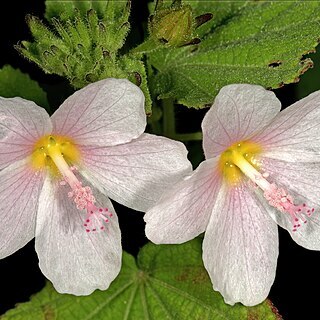Biennial or perennial, soft-stemmed suffrutex, 0.2-2.4 m high. Leaves suborbicular in outline, cordate, palmately veined, petiolate. Flowers axillary, solitary or in terminal pseudo-racemes; pedicels articulate ± 8 mm from apex. Epicalyx of 5 linear-lanceolate bracts, lobes less than 1.5 mm broad. Calyx cupuliform-campanulate, lobed to beyond middle, lobes triangular, conspicuously 3-nerved. Petals much longer than calyx, white or pink to mauve. Flowering time Aug.-May. Fruit enclosed in enlarged calyx. Mericarps 5, 1-seeded, lateral sides flat, muticous, glabrous, dorsally reticulate, ridges slightly raised. Seeds reniform, glabrous.
Leaf-lamina variable in dimensions, 2·5–12 × 2–15 cm., but usually of fairly uniform size on one specimen, usually broadly ovate to suborbicular in outline, usually 3–5-lobed almost to the middle, central lobe always the largest with usually gradually acute somewhat acuminate apex, the other lobes usually acute, base ± cordate, both surfaces usually finely pubescent or subhispid mainly on the veins and on the lower surface, the latter not infrequently subtomentose; petiole usually 1-8–6 cm. long (that of lower leaves occasionally much longer), pubescent to velutinous; stipules minute, filiform, pubescent, usually caducous.
Perennial herb or shrub, up to 2.4 m high. Leaves with blade broadly ovate to suborbicular, 25-120 x 20-150 mm, margins finely toothed. Flowers: epicalyx with linear segments, < 1.5 mm wide; calyx accrescent; petals 20-25 mm long, pink to mauve or white; Mar.-Jun. Fruit enclosed by a prominently veined calyx, mericarps with flat lateral veins.
Erect or somewhat spreading biennial or perennial soft-stemmed suffrutex or shrub, 1–2 m. tall, usually densely and rather shortly pubescent to subvelutinous (but both very hairy and sparsely pubescent extremes occur); stems rather stout, terete, with greyish or brownish pubescence, glabrescent.
Flowers mauve, pink or rose, solitary in the upper axils and on short lateral branches, often forming a terminal narrow leafy pseudo-panicle; pedicels usually under 9 mm. long, slender, tomentose and with additional long soft hairs.
Biennial or perennial herb or shrub, 1-2 m high. Leaves lobed to the middle. Calyx lobes with 3 conspicuous longitudinal nerves. Epicalyx of 5 bracts, as long as calyx. Mericarps muticous. Flowers mauve, pink or rose.
Calyx about as long as or a little longer than the epicalyx, cupuliform-campanulate, pubescent and ciliate, lobed to about the middle or a little beyond; lobes triangular, acute to apiculate, conspicuously 3-nerved.
Mericarps c. 3 mm. long, muticous, glabrous or nearly so, dorsally reticulate with slightly raised ridges.
Epicalyx of 5 bracts; bracts 5–8 mm. long, linear or narrowly lanceolate, pubescent, nearly free.
Seeds 3–3·5 × 2–2·5 mm., reniform, glabrous.
Staminal tube glabrous.
Petals 2–2·5 cm. long.

